Gillette
Gillette is an American brand of safety razors and other personal care products including shaving supplies, owned by the multi-national corporation Procter & Gamble (P&G).
 | |
| Product type | Safety razors, shaving supplies, personal care products |
|---|---|
| Owner | Procter & Gamble |
| Country | Boston, Massachusetts, U.S. |
| Introduced | September 28, 1901[1] |
| Markets | Worldwide |
| Previous owners | The Gillette Company |
| Tagline | "The Best a Man Can Get" (1989–2019) "The Best Men Can Be" (since 2019) |
| Website | www |
Based in Boston, Massachusetts, United States, it was owned by The Gillette Company, a supplier of products under various brands until that company merged into P&G in 2005. The Gillette Company was founded by King C. Gillette in 1901 as a safety razor manufacturer.[2]
Under the leadership of Colman M. Mockler Jr. as CEO from 1975 to 1991,[3] the company was the target of multiple takeover attempts, from Ronald Perelman[4] and Coniston Partners.[3] In January 2005, Procter & Gamble announced plans to merge with the Gillette Company.[5]
The Gillette Company's assets were incorporated into a P&G unit known internally as "Global Gillette". In July 2007, Global Gillette was dissolved and incorporated into Procter & Gamble's other two main divisions, Procter & Gamble Beauty and Procter & Gamble Household Care. Gillette's brands and products were divided between the two accordingly. The Gillette R&D center in Boston, Massachusetts, and the Gillette South Boston Manufacturing Center (known as "Gillette World Shaving Headquarters"), still exist as functional working locations under the Procter & Gamble-owned Gillette brand name.[6] Gillette's subsidiaries Braun and Oral-B, among others, have also been retained by P&G.
History
Inception and early years
The Gillette company and brand originate from the late 19th century, when salesman and inventor King Camp Gillette came up with the idea of a safety razor that used disposable blades. Safety razors at the time were essentially short pieces of a straight razor clamped to a holder. The blade had to be stropped before each shave and after a time needed to be honed by a cutler.[7] Gillette's invention was inspired by his mentor at Crown Cork & Seal Company, William Painter, who had invented the Crown cork. Painter encouraged Gillette to come up with something that, like the Crown cork, could be thrown away once used.[8][9]
While Gillette came up with the idea in 1895, developing the concept into a working model and drawings that could be submitted to the Patent Office took six years. Gillette had trouble finding anyone capable of developing a method to manufacture blades from thin sheet steel, but finally found William Emery Nickerson, an MIT graduate with a degree in chemistry. Gillette and other members of the project founded The American Safety Razor Company on September 28, 1901. The company had issues getting funding until Gillette's old friend John Joyce invested the necessary amount for the company to begin manufacturing.[10][8][9] Production began slowly in 1903, but the following year Nickerson succeeded in building a new blade grinding machine that had bottlenecked production. During its first year of operation, the company had sold 51 razors and 168 blades, but the second year saw sales rise to 90,884 razors and 123,648 blades. The company was renamed to the Gillette Safety Razor Company in 1904 and it quickly began to expand outside the United States. In 1905 the company opened a sales office in London and a blade manufacturing plant in Paris, and by 1906 Gillette had a blade plant in Canada, a sales operation in Mexico, and a European distribution network that sold in many nations, including Russia.[8][11]
First World War and the 1920s
Due to its premium pricing strategy, the Gillette Safety Razor Company's razor and blade unit sales grew at a modest pace from 1908 to 1916. Disposable razor blades still weren't a true mass market product, and barbershops and self-shaving with a straight razor were still popular methods of grooming. Among the general U.S. population, a two-day stubble was not uncommon. This changed once the United States declared war on the Central Powers in 1917; military regulations required every soldier provide their own shaving kit, and Gillette's compact kit with disposable blades outsold competitors whose razors required stropping. Gillette marketed their razor by designing a military-only case decorated with U.S. Army and Navy insignia and in 1917 the company sold 1.1 million razors.[12]
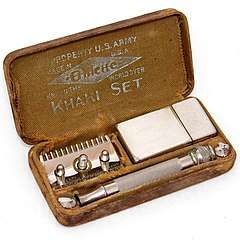
In 1918, the U.S. military began issuing Gillette shaving kits to every U.S. serviceman. Gillette's sales rose to 3.5 million razors and 32 million blades. As a consequence, millions of servicemen got accustomed to daily shaving using Gillette's razor. After the war, Gillette utilised this in their domestic marketing and used advertising to reinforce the habit acquired during the war.[12]
Gillette's original razor patent was due to expire in November 1921 and to stay ahead of upcoming competition, the company introduced the New Improved Gillette Safety Razor in spring 1921 and switched to the razor and blades pricing structure the company is known for today. While the New Improved razor was sold for $5 (equivalent to $72 in 2019) – the selling price of the previous razor – the original razor was renamed to the Old Type and sold in inexpensive packaging as "Brownies" for $1 (equivalent to $14 in 2019). While some Old Type models were still sold in various kinds of packaging for an average price of $3.50, the Brownie razors made a Gillette much more affordable for the average person and expanded the company's blade market significantly. From 1917 to 1925, Gillette's unit sales increased tenfold. The company also expanded its overseas operations right after the war by opening a manufacturing plant in Slough, near London, to build New Improved razors, and setting up dozens of offices and subsidiaries in Europe and other parts of the world.[14]
Gillette experienced a setback at the end of the 1920s as its competitor AutoStrop sued for patent infringement. The case was settled out of court with Gillette agreeing to buy out AutoStrop for 310,000 non-voting shares. However, before the deal went through, it was revealed in an audit that Gillette had been overstating its sales and profits by $12 million over a five-year period and giving bonuses to its executives based on these numbers. AutoStrop still agreed to the buyout but instead demanded a large amount of preferred stock with voting rights. The merger was announced on October 16, 1930, and gave AutoStrop's owner Henry Gaisman controlling interest in Gillette.[15]
1930s and the Second World War

The Great Depression weakened Gillette's position in the market significantly. The company had fallen behind its competitors in blade manufacturing technology in the 1920s and had let quality control slip while over-stretching its production equipment in order to hurry a new Kroman razor and blade to market in 1930. In 1932, Gillette apologized for the reduction in blade quality, withdrew the Kroman blade, and introduced the Blue Blade (initially called the Blue Super Blade) as its replacement.[16] Other Gillette introductions during the Depression years were the Brushless Shaving Cream and an electric shaver that was soon discontinued due to modest sales.[17]
In 1938 Gillette introduced the Thin Blade, which was cheaper and about half the weight of the Blue Blade, even though it cost almost as much to manufacture. The Thin Blade became more popular than the Blue Blade for several years during the Second World War due to high demand of low-cost products and the shortage of carbon steel.[18] Beginning in 1939, Gillette began investing significant amounts on advertising in sports events after its advertising in the World Series increased sales more than double the company had expected.[19]
Though competition hit Gillette hard in the domestic market during the Great Depression, overseas operations helped keep the company afloat. In 1935 more than half of Gillette's earnings came from foreign operations and in 1938 – the worst of the Depression years for Gillette, with a mere 18 percent market share – nearly all of the company's $2.9 million earnings came from outside the U.S. AutoStrop's Brazilian factory allowed Gillette to start expanding into the Latin America, in England the Gillette and AutoStrop operations were combined under the Gillette name, and the company built a new blade manufacturing plant in London. In 1937, Gillette's Berlin factory produced 40 percent of Germany's 900 million blades and retained a 65 to 75 percent share of the German blade market.[20]
The Second World War reduced Gillette's blade production both domestically and internationally. As a result of the war, many markets were closed off, German and Japanese forces expropriated the company's plants and property, and Gillette's plants in Boston and London were partially converted for weapons production. In 1942 the War Production Board ordered Gillette to dedicate its entire razor production and most blade production to the U.S. military. By the end of the war, servicemen had been issued 12.5 million razors and 1.5 billion blades. Gillette also assisted the U.S. army in military intelligence by producing copies of German razor blades for secret agents venturing behind German lines so that their identities wouldn't be compromised by their shaving equipment. The company also manufactured razors that concealed money and escape maps in their handles, and magnetic double-edge blades that prisoners of war could use as a compass.[21]
Recovery from the war and diversification
During the post-war years, Gillette began to quickly ramp up production by modernizing its major manufacturing plants in the United States and England, expanding the capacity of several foreign plants, and re-opening plants closed during the war. The company opened a new plant in Switzerland and began manufacturing blades in Mexico City. Sales rose to $50 million in 1946 and in 1947 Gillette sold a billion blades. By 1950, Gillette's share of the U.S. blade market had climbed to 50 percent.[22] During the 1950s, the company updated and in some cases moved some of its older European factories: the Paris factory, for example, was moved to Annecy.[23]
_(30521266125).jpg)
In 1947 Gillette introduced the Gillette Super Speed razor and along with it the Speed-pak blade dispenser the company had developed during the war. The dispenser allowed the blade to be slid out of the dispenser into the razor without danger of touching the sharp edge. It also had a compartment for holding used blades.[24][25]
In 1948 Gillette bought the home permanent kit manufacturer The Toni Company[26] and later expanded into other feminine products such as shampoos and hair sprays. In 1955 the company bought the ballpoint pen manufacturer Paper Mate.[24][27] In 1960 Gillette brought into market the Right Guard aerosol deodorant and bought the disposable hospital supplies manufacturer Sterilon Corporation in 1962.[28]
Television advertising played a big part in Gillette's post-war growth in the United States. The company began TV advertising in 1944 and in 1950 it spent $6 million to acquire exclusive sponsorship rights to the World Series for six years. By the mid-1950s, 85 percent of Gillette's advertising budget was used for television advertising. The company also advertised the Toni product line by sponsoring the TV show Arthur Godfrey and His Friends and the 1958 Miss America contest and its winner.[29][30]
Although Gillette's immediate priority after the war was satisfying U.S. demand and later diversifying its domestic business, the company pursued expansion in foreign markets that showed potential for growth, such as Latin America and Asia. However, the Cold War restricted Gillette's operations in many parts of the world and closed entire markets the company would've otherwise entered in Russia, China, Eastern Europe, Near East, Cuba, and parts of Asia. More and more countries demanded local ownership for foreign enterprise in exchange for continued operation or entry into their markets. Outside the U.S. and European markets, Gillette spent time and money building manufacturing facilities and distribution networks in anticipation that the markets would eventually be opened up and nationalistic restrictions lifted. Some of Gillette's joint ventures included a 40 percent Gillette 60 percent Malaysian mini-plant operation that began production in 1970, and an Iranian manufacturing plant with 51 percent government ownership. The Iran plant was one of Gillette's largest and most modern factories until the Iranian Revolution of 1979 when Ayatollah Khomeini rose into power and American businesses were targeted as enemies of the new government, forcing Gillette to abandon the operation and withdraw from the country.[31]
Super Blue and the Wilkinson shock
In 1960, Gillette introduced the Super Blue blade, the company's first coated blade and the first significantly improved razor blade since the Blue Blade of the 1930s. The new blade was coated with silicone and in Gillette's laboratory testing produced much more comfortable and close shaves by reducing the blade's adhesion to whiskers. Super Blue was a success and sold more than the Blue Blade and Thin Blade combined. By the end of 1961, Gillette's double edge blade market share had risen to 90 percent and the company held a total razor blade market share of 70 percent.[32]
In 1962, roughly two years after the introduction of the Super Blue blade, Wilkinson Sword introduced the world's first razor blade made from stainless steel. According to users, the blade stayed sharp about three times longer than the best carbon steel blades – including Gillette's. Wilkinson's introduction took Gillette by surprise and the company struggled to respond as its smaller rivals, Schick and the American Safety Razor Company, came out with their own stainless steel blade. However, during the development of the silicon coating for the Super Blue blade, Gillette had also discovered the method of producing coated stainless steel blades that Wilkinson Sword was using and managed to patent it before Wilkinson did. The English company was forced to pay royalty to Gillette for each blade it sold.[33]
Gillette hesitated in bringing its own stainless steel blades to market as Super Blue had been a huge success and replacing it with a longer-lasting blade would've reduced profits. The company eventually brought the Gillette Stainless blade to the market in August 1963, about a year after Wilkinson's stainless blades. As a result of the affair, Gillette's share of the double-edge blade market dropped from 90 percent to about 70 percent.[33]
Two years after the introduction of the Gillette Stainless blades, the company brought out the Super Stainless blades – known in Europe as Super Silver – that were made from an improved steel alloy. Gillette also introduced the Techmatic, a new type of razor that used a continuous spool of stainless blade housed in a plastic cartridge.[34][35]
The success of the coated Super Blue blades marked the start of a period when chemistry became as important metallurgy in Gillette's blade manufacturing. The Super Blue's coating was a result of teamwork between the Gillette's British and American scientists.[36] As a result of the Wilkinson ordeal, Gillette's then-chairman Carl Gilbert increased the company's spending on research and development facilities in the U.S., championed the building of a research facility in Rockville, Maryland, and encouraged further expansion of R&D activities in England.[37]
Trac II: The move to cartridge razors
The development of Gillette's first twin-blade razor began in early 1964 in the company's Reading laboratories in England when a new employee Norman C. Welsh experimented with tandem blades and discovered what he called the "hysteresis effect"; a blade pulling the whisker out of the hair follicle before cutting it, and enabling a second blade cut the whisker even shorter before it retracted back into the follicle. For six years afterwards, Welsh and his colleagues worked on a means of utilizing the hysterisis effect, almost exclusively concentrating on what would later be known as the Atra twin-blade system. The Atra razor featured two blades set in a plastic cartridge with edges that faced each other. Using the razor required the user to move it in an up-and-down scrubbing motion, and whiskers were cut on both the up and down strokes. Another twin-blade system with blades set in tandem, codenamed "Rex", also existed, but it had too many technical problems and was behind Atra in development.[38]
In consumer tests, the Atra razor had outperformed existing razor systems, but Gillette's marketing executives feared the razor would meet resistance among shavers due to the unfamiliar scrubbing motion required to use it. Even though the Atra project was so far along in mid-1970 that packaging and production machinery was nearly ready for a full market introduction, Gillette decided to start a development drive to finish Rex instead as it didn't require learning a new way to shave. The project succeeded, Atra was abandoned, and Gillette announced the first twin-blade razor – now renamed to Trac II – in fall of 1971. The Trac II captured the premium shaving market and came out in time to counter Wilkinson Sword's Bonded Blade system that utilised single-blade cartridges.[39]
The challenge of disposables
In 1974, the French Société Bic introduced the world's first disposable razor. The razor was first brought to market in Greece, where it sold well, after which it was introduced to Italy and many other European countries. Gillette hurried to develop their own disposable before Bic could bring their razor to the United States. Gillette designed a single-blade razor similar to Bic's but soon abandoned the concept in favor of a razor that was essentially a Trac II cartridge molded into a blue plastic handle. Gillette introduced this disposable as the Good News in 1976, about a year before Bic's razor reached the United States, and managed to establish market leadership once Bic and other competitors came to market. Good News was released under various names in Europe and was equally and sometimes even more successful than Bic's razor. Gillette quickly brought its razor to markets Bic hadn't yet reached, such as Latin America where the razor was known as Prestobarba.[40]
In Latin America, Gillette used a so-called cannibalization strategy by selling the razor in several market segments: along with the heavily advertised Prestobarba, the razor was also sold under different names – such as Permasharp in Mexico and Probak in Brazil – and sold for at least 10 to 15 percent less. The less expensive variants were differentiated from the blue Prestobarba by manufacturing them from yellow plastic, and in addition they weren't advertised. The strategy was successful and later market arrivals were unable to gain a major foothold. Once the approach proved to be a successful one, Gillette's subsidiaries in Russia, Poland, and multiple Asian and Near Eastern markets began utilising the same strategy.[41]
While Gillette managed to retain market leadership against Bic and other competitors, the popularity of disposable razors, their higher production cost compared to cartridges, and price competition eroded the company's profits. Gillette had at first hoped that disposables would take no more than 10 percent of the total razor and blades market, but by 1980, disposables accounted for more than 27 percent of the world shaving market in terms of unit sales, and 22 percent of total revenue.[42][43] John W. Symons began steering Gillette into a different direction after becoming the director of Gillette's European Sales Group in 1979. Despite Gillette's strong sales and large share of the European razor and blades market – 70 percent, which was higher than in the United States – cash flow was declining. In Symons's view, the issue was Gillette's attempt to compete with Bic in the disposables market, which was eating into the sales of its more profitable cartridge razors. Symons reduced the marketing budget of disposables in Europe and hired the advertising agency BBDO's London branch to create an ad campaign to make Gillette's blade and razor systems – such as Contour – more desirable in the eyes of men. The new marketing strategy, combined with cutting costs and centralizing production increased profits. In 1985, Gillette's profits in the European market were $96 million, while two years previously they were $77 million.[44]

In 1980, Gillette introduced Atra – known in Europe as Contour – a twin-blade razor with a pivoting head. The razor became a best-seller in the United States during its first year and eventually became a market leader in Europe.[45]
Product history
Double-edged safety razors
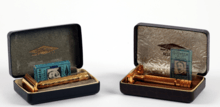
The first safety razor using the new disposable blade went on sale in 1903.[6] Gillette maintained a limited range of models of this new type razor until 1921 when the original Gillette patent expired.[2] In anticipation of the event, Gillette introduced a redesigned razor and offered it at a variety of prices in different cases and finishes, including the long running “aristocrat". Gillette continued to sell the original razor but instead of pricing it at $5, it was priced at $1, making a Gillette razor truly affordable to every man regardless of economic class. In 1932 the Gillette Blue Blade, so-named because it was dipped in blue lacquer, was introduced. It became one of the most recognizable blades in the world. In 1934 the "twist to open" (TTO) design was instituted, which featured butterfly-like doors that made blade changing much easier than it had been, wherein the razor head had to be detached from the handle.
Razor handles continued to advance to allow consumer to achieve a closer shave. In 1947, the new (TTO) model, the "Super Speed", was introduced. This was updated in 1955, with different versions being produced to shave more closely — the degree of closeness being marked by the color of the handle tip.
In 1955, the first adjustable razor was produced. This allowed for an adjustment of the blade to increase the closeness of the shave. The model, in various versions, remained in production until 1988.[46]
.jpg)
The Super Speed razor was again redesigned in 1966 and given a black resin coated metal handle. It remained in production until 1988. A companion model the,"Knack", with a longer plastic handle, was produced from 1966 to 1975. In Europe, the Knack was sold as "Slim Twist" and "G2000" from 1978 to 1988, a later version known as "G1000" was made in England and available until 1998. A modern version of the Tech, with a plastic thin handle, is still produced and sold in several countries under the names 7 O'clock, Gillette, Nacet, Minora, Rubie and Economica.
Discontinued products
- Techmatic was a single blade razor introduced in the mid-1960s. It featured a disposable cartridge with a razor band which was advanced by means of a lever. This exposed an unused portion the band and was the equivalent of five blades.
- Adjustable Techmatic was a version of the Techmatic dating from 1970. The adjustable version featured user-selection of shave closeness on the cartridge. The adjustable version was interchangeable with the non-adjustable version. Both versions of the Techmatic and their cartridges have been discontinued.
- Trac II was the world's first two-blade razor, debuting in 1971.[47] Gillette claimed that the second blade cut the number of strokes required and reduced facial irritation.
- Trac II Plus was an identical model but adds a lubricating strip at the top of the blade. The blades and handles were interchangeable.
- The European versions of the Trac II and Trac II Plus were known as the GII and GII Plus respectively.
- Atra (known as the Contour, Slalom, Vector in some markets) was introduced in 1977[2] and was the first razor to feature a pivoting head, which Gillette claimed made it easier for men to shave their necks.
- Atra Plus featured a lubricating strip, dubbed Lubra-Soft.
Current products
- Good News! is a currently produced first disposable, double-blade razor, released in 1976.
- The Good News! comes in three forms: the "Original", the "Good News! Plus", which includes a lubricating strip, and the "Good News! Pivot Plus", which features a lubricating strip and a pivoting head.
- Gillette Sensor debuted in 1990,[48] and was the first razor to have spring-loaded blades. Gillette claimed the blades receded into the cartridge head, when they make contact with skin, helping to prevent cuts and allowing for a closer shave.
- The Sensor for Women was released around the same time and was nearly identical, but had a wider cartridge head.
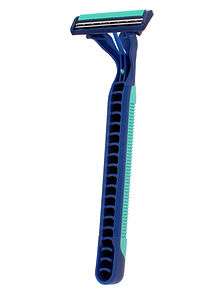 Gillette Blue II razor, circa 2007
Gillette Blue II razor, circa 2007
- Sensor Excel was released in 1993. This featured "Microfins", a piece of rubber with slits at the bottom of the cartridge which Gillette claimed this helped to raise facial hairs, making for a closer shave.
- Sensor 3 had three blades instead of two. All Sensor handles can use all Sensor cartridges.
- Blue II is a line of disposable razors. In Latin America, it was marketed as the Prestobarba.
- Blue 3 is a line of three-blade razors, cheaper version of Sensor 3 (Sensor compatible). It's only available also in disposable variant.
- Custom Plus is a series of disposable razors
- The Custom Plus comes in many varieties: the "Fixed Disposable razor", the "Pivot Disposable razor", the "Custom Plus 3 Sensitive Disposable", and the "Custom Plus 3 Soothing Disposable".
- Mach 3 - the first three-blade razor, introduced in 1998,[49] which Gillette claims reduces irritation and requires fewer strokes. In 2016, P&G upgraded the Gilette Mach 3 razor.[50]
- The Mach 3 featured five improved microfins and spring blades, a pivoting head with greater flexibility and a blue lubrication strip that faded with usage to encourage users to change their blades more frequently.
- Mach 3 disposable - the Mach 3 with a plastic handle.
- Mach 3 Turbo - this razor was released in late 2001. It had ten microfins as opposed to the five on the original, a new grip and claims improved lubrication and "anti-friction" blades.
- All Mach 3 blades are interchangeable between the three products in the range, so it is possible to use the Mach3 Turbo blades on a Mach3 razor.
- Mach 3 Turbo Champion has a slightly different handle design.
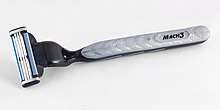 Gillette Mach 3 razor, circa 2015
Gillette Mach 3 razor, circa 2015
- Mach 3 Turbo Champion has a slightly different handle design.
- Mach 3 Power is a battery-powered version of the Mach3 Turbo razor which can also be used with the power switched off. The blades differ from Mach 3 Turbo with a new coating which Gillette describes as "PowerGlide".
- Mach 3 Sensitive was awarded a 2012 Best New Product Award after being voted 'Best in Show' in the program's awards in Mexico.
- The lubrication and microfins are identical to Mach3Turbo. The Mach3 Power Nitro has a slightly different handle design.
- Venus is a division of razors for women.
- Venus Divine is a version of the Mach3 Turbo for women.
- Venus Vibrance is a version of the M3Power for women. Venus blades are interchangeable across the line.
- Venus Embrace is a five-bladed razor with a ribbon of moisture surrounding the blades.
- Venus Breeze is a three-blade razor with shave gel bars built into the head of the razor.
- Another version of the Breeze, the Venus Spa Breeze, is essentially the same as the Breeze, but with a white tea scent to the shave gel bars.[51]
- Venus ProSkin Moisture Rich, launched in January 2011 in the United States, is an updated version of the Breeze, featuring Moisture Rich shave-gel bars that are enhanced with a triple blend of body butters.[52]
- Gillette Fusion is a five-bladed razor released in 2006. The Fusion has five blades on the front, and a single sixth blade on the rear for precision trimming. Its marketing campaign was fronted by the sports stars Roger Federer, Thierry Henry and Tiger Woods.
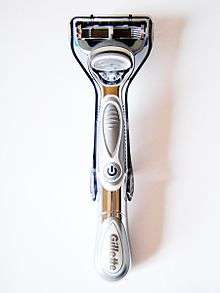 Gillette Fusion ProGlide Power
Gillette Fusion ProGlide Power
- Gillette Fusion Power is a motorized version of the Fusion. The Fusion Power is battery-powered and emits "micropulses" that are claimed to increase razor glide.[53]
- Fusion Power Phantom - the Fusion Power Phantom (Stealth in UK) was released in February 2007 and features a redesigned handle with a darker color scheme than the original.
- Fusion Power Phenom was released in February 2008. It has a blue and silver color scheme.[54]
- Fusion ProGlide and Fusion ProGlide Power were launched on June 6, 2010, in North America.
- The ProGlide series feature re-engineered blades with edges that are thinner than Fusion and are finished with low-resistance coating which the company claims allow the blades to glide more easily through hair.[55]
- Fusion Proshield Flexball released in November 2015: the blades have lubrication before and after the blade so that it protects the skin while shaving.
- Fusion Power Gamer (known as "Cool White" in some markets)
- Fusion ProGlide FlexBall released in June 2014[56]
Criticism and controversy
The desire to release ever more expensive products, each claiming to be the "best ever", has led Gillette to make disputed claims for its products. In 2005, an injunction was brought by rival Wilkinson Sword which was granted by the Connecticut District Court which determined that Gillette's claims were both "unsubstantiated and inaccurate" and that the product demonstrations in Gillette's advertising were "greatly exaggerated" and "literally false". While advertising in the United States had to be rewritten, the court's ruling does not apply in other countries.[58]
Procter & Gamble (P&G) shaving products have been under investigation by the UK Office of Fair Trading as part of an inquiry into alleged collusion between manufacturers and retailers in setting prices.
Gillette was fined by Autorité de la concurrence in France in 2016 for price fixing on personal hygiene products.[59]
"Toxic masculinity" advertisement
In January 2019, Gillette began a new marketing campaign, "The Best Men Can Be", to mark the 30th anniversary of the "Best a Man Can Get" slogan. The campaign was introduced with a long-form commercial entitled "We Believe", and aims to promote positive values among men—condemning acts of bullying, sexism, sexual assault, and toxic masculinity. While the campaign received praise for its acknowledgement of current social movements and for promoting positive values of masculinity, it also faced a negative response—including from right-wing critics[60]—being called left-wing propaganda, accusatory towards its customers, and misandrist and there were calls for boycotts of Gillette.[61][62][63][64][65]
Net worth
In 1999, Gillette, as a company, was worth US$43 billion, and it was estimated that the brand value of Gillette was worth US$16 billion. This equated to 37% of the company's value, which was the same as DaimlerChrysler, one of the world's largest car manufacturers at the time.[66]
Marketing

Gillette first introduced its long-time slogan, "The Best a Man Can Get", during a commercial first aired during Super Bowl XXIII in 1989.[64]
The company has had sponsorships in Major League Baseball and the England national rugby league team, along with the Rugby League Four Nations. Athletes such as Roger Federer, Tiger Woods, Shoaib Malik, Derek Jeter, Thierry Henry, Kenan Sofuoglu, Park Ji-Sung, Rahul Dravid, and Michael Clarke are sponsored by the company, as well as video gaming personality Dr DisRespect.[67]
In November 2009, Gillette became the subject of a proposed boycott in Ireland due to its endorsement by French soccer player Thierry Henry; his undetected handball foul during a FIFA World Cup qualifying match contributed to a game-winning goal by France, eliminating Ireland from contention.[68] The following month, expanding upon the controversy, media outlets observed a "curse" associated with top athletes who endorse Gillette, also citing Tiger Woods (who became the subject of an infidelity scandal in late-2009), and Roger Federer losing in an upset to Nikolay Davydenko during the 2009 ATP World Tour Finals.[69]
Upon its opening in 2002, Gillette has held naming rights to Gillette Stadium in nearby Foxborough, home of the New England Patriots of the National Football League. The original agreement lasted through 2017; in 2010, P&G reached a 15-year extension, lasting through 2031.[70]
Since the 1990s, the company has used a marketing list to send a free sample of a Gillette razor in promotional packages to men in celebration of their 18th birthday. The campaign has occasionally resulted in the samples accidentally being sent to recipients outside of the demographic, such as a 50-year-old woman (exacerbated by the package containing the slogan "Welcome to Manhood").[71][72]
In science
In laser research and development, Gillette razor blades are used as a non-standard measurement used as a rough estimate of a particular device's penetrative ability; a "four-Gillette laser", for example, can burn through four blades.[73]
In Music
Science isn't the only unusual setting far removed from hygiene in which a Gillette razor blade has been used. Some music bands have also used Gillette razor blades in order to achieve a certain sound, most notably English rock band The Kinks. Kinks member Dave Davies became "really bored with this guitar sound - or lack of an interesting sound" so he purchased "a little green amplifier ...an Elpico" from a radio spares shop in Muswell Hiil,[74] and "twiddled around with it", including "taking the wires going to the speaker and putting a jack plug on there and plugging it straight into my AC30" (a larger amplifier), but didn't get the sound he wanted until he got frustrated and "got a single-sided Gillette razorblade and cut round the cone [from the centre to the edge] ... so it was all shredded but still on there, still intact. I played and I thought it was amazing."[75] The sound was replicated in the studio by having the Elpico plugged into the Vox AC30. It was this sound, courtesy of a Gillette razor blade that became a mainstay on many of The Kinks early recordings, most notably on "You Really Got Me" and "All Day and All of the Night".[76]
Canadian headquarters
Until the late 1980s, Gillette Canada's headquarters were in the Montreal suburb of Mont-Royal, Quebec until they moved west to another Montreal suburb in Kirkland. The Kirkland offices were closed in 1999 and Gillette Canada moved to Mississauga, Ontario, a Toronto suburb following the Gillette acquisition of Duracell. The Mississauga offices were closed in 2005-06 after Procter & Gamble acquired Gillette, and Gillette's Canadian headquarters are located in downtown Toronto with parent Procter & Gamble on Yonge St.
References
- SRINIVASAN, R. CASE STUDIES IN MARKETING: THE INDIAN CONTEXT. PHI Learning Pvt. Ltd. ISBN 9788120349964.
- "Gillette IN HIS EARLY DAYS THE INVENTOR OF THE RAZOR AND THE COMPANY HE BUILT SURVIVED MANY CLOSE SHAVES WITH FINANCIAL RUIN. BUT HIS FAME NEVER TRANSLATED INTO A PERSONAL FORTUNE. - April 1, 2003". money.cnn.com. Retrieved 2019-10-23.
- Fowler, Glenn (1991-01-26). "Colman M. Mockler Jr. Dies at 61, Gillette's Top Executive Since 70's". The New York Times. ISSN 0362-4331. Retrieved 2019-09-18.
- "Gillette chairman dies of heart attack". UPI. Retrieved 2019-09-18.
- "Procter & Gamble Acquires Gillette". www.cbsnews.com. Retrieved 2019-09-18.
- "Gillette history". gillette.com. Retrieved August 22, 2014.
- McKibben 1998, p. 5.
- McKibben 1998, p. 7-8.
- Gillette 1918.
- "Gillette Blade". National History of American History. Smithsonian Institution. Retrieved 29 October 2019.
- company renamed
- McKibben 1998, p. 18-20.
- Gillette U.S. Service Razor Set
- McKibben 1998, p. 20-21.
- McKibben 1998, p. 29-30.
- McKibben 1998, p. 29-33.
- McKibben 1998, p. 34.
- McKibben 1998, p. 35.
- McKibben 1998, p. 36-39.
- McKibben 1998, p. 34-35.
- McKibben 1998, p. 39-40.
- McKibben 1998, p. 40-45.
- McKibben 1998, p. 61.
- McKibben 1998, p. 44-45.
- Waits 2014, p. 466.
- McKibben 1998, The legend of the "Which twin has the Toni?" advert between pages 52 and 53.
- A Permanent Contribution: When Gillette bought a hot startup in an effort to diversify, it got something even better: the entrepreneur behind the product.
- McKibben 1998, p. 54-55.
- McKibben 1998, p. 49-52.
- Gillette Co.
- McKibben 1998, p. 61-66.
- McKibben 1998, p. 53-54.
- McKibben 1998, p. 56-58.
- McKibben 1998, p. 58.
- Waits 2014, p. 468.
- McKibben 1998, p. 53.
- McKibben 1998, p. 59.
- McKibben 1998, p. 67-68.
- McKibben 1998, p. 67-69.
- McKibben 1998, p. 97-98.
- McKibben 1998, p. 336-337.
- McKibben 1998, p. 98-99.
- Gillette and the men's wet-shaving market, page 2
- McKibben 1998, p. 114-117.
- McKibben 1998, p. 96.
- "Vintage Gillette Adjustable Double Edge Razors". GilletteAdjustable.com. Retrieved 12 March 2017.
- Tiffany, Kaitlyn. "The absurd quest to make the "best" razor". Vox. Retrieved 2019-09-18.
- "Manufacturing can thrive but struggles for respect". Reuters. 2011-12-14. Retrieved 2019-09-18.
- Tiffany, Kaitlyn (2018-12-11). "The absurd quest to make the "best" razor". Vox. Retrieved 2019-09-18.
- Brunsman, Barrett. "P&G upgrades Gillette razor for first time in nearly a decade". Cincinnati Business Courier. Retrieved 2019-09-18.
- "Gillette Venus: Venus Spa Breeze 2-in-1 Razor" Archived 2011-07-11 at the Wayback Machine, gillettevenus.com; accessed August 22, 2014.
- "Gillette Venus: ProSkin MoistureRich Razor" Archived 2011-03-06 at the Wayback Machine, gillettevenus.com; accessed August 22, 2014.
- "Gillette - Men's Razors & Shaving Products". gillette.com.
- "Gillette Unveils Newest Members of Its Gillette Young Guns Lineup" (Press release). Gillette. February 11, 2008. Archived from the original on September 7, 2012. Retrieved February 15, 2008.
- Gillette Fusion ProGlide Shaving Razor for Men, Official website; accessed August 22, 2014.
- Eisen, Sara (2014-05-01). "Gillette hopes for a swivel in sales from new razor". CNBC. Retrieved 2019-10-23.
- "Gillette's New Razor Is Everything That's Wrong With American Innovation". Intelligencer. Retrieved 2019-10-23.
- "Truth in advertising", Gizmag; accessed August 22, 2014.
- "Huge price-fixing fine is upheld". The Connexion. 28 October 2016. Archived from the original on 9 February 2017.
- "Gillette's Ad Is More Conservative Than Critics Think". National Review. 2019-01-17. Retrieved 2019-01-17.
- "Gillette faces talks of boycott over ad campaign railing against toxic masculinity". ABC News. 2019-01-16. Retrieved 2019-01-16.
- Green, Dennis (2019-01-14). "Gillette chastises men in a new commercial highlighting the #MeToo movement — and some are furious". Business Insider. Retrieved 2019-01-14.
- "Gillette released an ad asking men to 'act the right way.' Then came the backlash". Boston.com. 2019-01-14. Retrieved 2019-01-15.
- "Gillette Asks How We Define Masculinity in the #MeToo Era as 'The Best a Man Can Get' Turns 30". Adweek. Retrieved 2019-01-15.
- "Gillette's new take on 'Best a Man Can Get' in commercial that invokes #MeToo". Advertising Age. Retrieved 2019-01-15.
- Jane Pavitt. Brand New, September 2000. ISBN 0-691-07061-X.
- "CAA Signs Twitch Streamer DrDisrespect (Exclusive)". The Hollywood Reporter. Retrieved 2019-01-15.
- Ronay, Barney (2009-11-19). "Hands-on Thierry Henry becomes public enemy numéro un". The Guardian. ISSN 0261-3077. Retrieved 2019-01-15.
- "'Kennett Curse' has nothing on these". Courier Mail. 2013-09-18. Retrieved 2019-01-15.
- "Naming-rights deal extended through 2031". Boston.com. 2010-09-22. Retrieved 2019-01-15.
- Maheshwari, Sapna (2017-07-16). "Welcome to Manhood, Gillette Told the 50-Year-Old Woman". The New York Times. ISSN 0362-4331. Retrieved 2019-01-15.
- "Retail's new niche: Aging baby boomers". The Gazette. Retrieved 2019-01-15.
- Rachel Zurer (December 27, 2011). "Three Smart Things About Lasers". Wired. Retrieved May 21, 2015.
- https://web.archive.org/web/20160425162920/http://www.davedavies.com/guitars/guitars2.htm
- https://web.archive.org/web/20150712032915/http://www.davedavies.com/articles/tgm_0199-01.htm
- https://www.allmusic.com/artist/the-kinks-mn0000100160
Bibliography
- McKibben, Gordon (1998). Cutting Edge: Gillette's Journey to Global Leadership. Harvard Business School Press. ISBN 0-87584-725-0.CS1 maint: ref=harv (link)
- Waits, Robert K. (2014). A Safety Razor Compendium: The Book. ISBN 978-1-312-29353-3.CS1 maint: ref=harv (link)
- Gillette, King Camp (February 1918). "Origin of the Gillette Razor". The Gillette Blade. Boston: Gillette Safety Razor Company.CS1 maint: ref=harv (link)
Further reading
- "King C. Gillette, The Man and His Wonderful Shaving Device" by Russell Adams (1978), published by Little Brown & Co. of Boston, Massachusetts, U.S.
- Rodriguez, Ginger G.; Salamie, David E.; Shepherd, Kenneth R. (2005) [previous versions of the article in the volume 3 and 20]. Grant, Tina (ed.). "The Gillette Company". International Directory of Company Histories. Farmington Hills, Michigan: St.James Press (Thomson Gale). 68: 171–176. ISBN 1-55862-543-7.
External links
| Wikimedia Commons has media related to Gillette. |
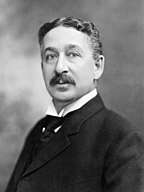
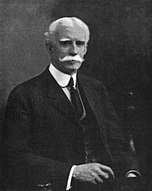
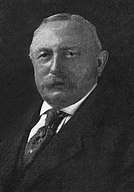
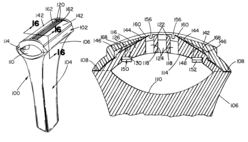
.jpg)